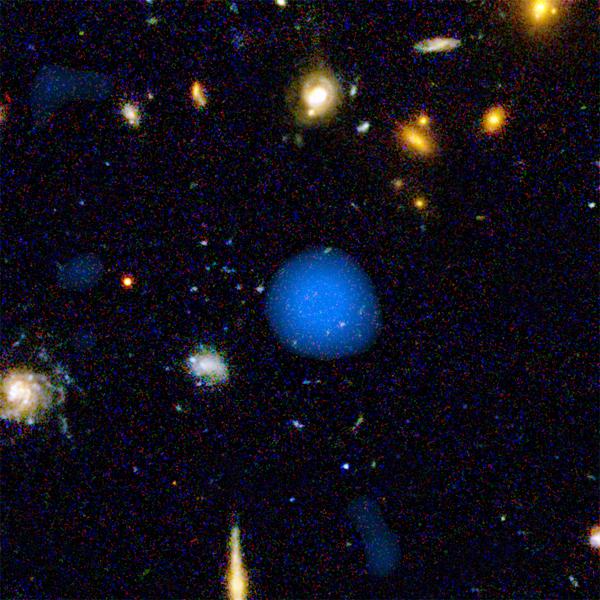
This combined optical and X-ray deep image shows some of the faintest galaxies ever seen, along with the X-ray glow (in blue) from heated material in the environment of a black hole that is in the same region of the sky.
The existence of black holes is one of the most amazing and bizarre predictions of Einstein's theory of gravity. Despite his original
misgivings about their reality, massive black hole holes are today believed to lie at the centers of most galaxies and to be the inevitable
consequence of the demise of massive stars. A black hole is point-like in dimension, but one of its more mysterious aspects is that it has an
"event horizon": an imaginary surface, or "edge," of finite size around it within which anything (except information) that ventures becomes lost forever to the rest of the universe. The existence and nature of event horizons are much less well understood than black holes themselves. Some proposed,
variant theories of gravity to Einstein's, for example, differ in their predicted properties of event horizons, while in some other scenarios
event horizons might not even exist. Since black holes are seemingly so common, astronomers want to understand these curious surfaces around them. Their findings could also help refine or suppliant Einstein's theory, and would offer clues to the fundamental nature of physical forces and particles by virtue of the extreme environment of black holes.
Observations of event horizons are extraordinarily difficult because they are comparatively so small - our own galactic center's black hole has one estimated to be less than 40 astronomical units in diameter - and
faint because light passing through the surface is captured. Nevertheless, accretion of material onto disks or other structures near the event horizon produces radiation at all wavelengths, much of which escapes the region and can be seen, and the environment thus probed.
In the case of our galactic center, recent observations from a team including CfA astronomers with the Submillimeter Array have set some important constraints. Writing in the latest issue of the Astrophysical Journal, CfA astronomers Avi Loeb and Ramesh Narayan, together with a past post-doc of theirs, have used this and other new results to compute the implications for any putative event horizon. They show for the first time, making only a few conservative assumptions, that there is now solid evidence for one of the most exotic and fundamental predictions of general relativity: the existence of an event horizon around the galactic center black hole, and therefore around black holes in general.